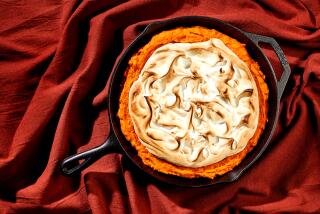A Potato Both Sweet, Healthful for Body
- Share via
Those highly versatile tubers, sweet potatoes, are among the most nutritious vegetables around and should be a part of a healthy diet all year long--providing, of course, that you go easy on the butter, brown sugar and marshmallows.
There are several misconceptions about sweet potatoes. First, they are not really potatoes at all but are actually members of the morning glory family. If you’ve ever tried to grow a plant from sweet potato cuttings, you’ll see the similarity.
Second, although they are naturally sweet, sweet potatoes do not have any more calories than a white potato (about 100 per 3.5-ounce serving).
The sweetness comes from a natural enzyme that converts most of the starch in the root to sugar as the sweet potato matures and continues even after harvest, during storage and while cooking.
Finally comes the myth that yams and sweet potatoes are the same. They are not.
In the United States, you’re most likely to see the moist, orange-fleshed varieties of sweet potatoes, which are often incorrectly called yams.
In fact, true yams are very large, fleshy roots that can grow to 100 pounds or so and are mostly found in Africa, Asia and the Caribbean. They are not nearly as nutritious as sweet potatoes.
Another common variety of sweet potato has a drier, pale-yellow flesh and a skin that is also lighter in color.
If you opt for the sweet potatoes with the dark-reddish skin and yellow-orange flesh, you will get a huge nutritional bargain. One 3.5-ounce serving of cooked sweet potato (leave off the butter, please) has about 10 milligrams of beta carotene (about the same as a carrot) plus 30 milligrams of vitamin C, along with folic acid, B vitamins and some vitamin E. All this with no fat and for very little money.
Look for potatoes that are heavy for their size and smooth, hard and without bruises or decay, which shows up as a shriveled or shrunken area. Since decay usually begins at the tip, check them out carefully.
Once decay gets into a potato, it can give the tuber an off-taste. If you’re planning to cook sweet potatoes whole, make sure they’re all about the same size.
Sweet potatoes will spoil rapidly and should be kept in a cool place but never in the refrigerator. If you are able to keep them at about 55 degrees, they will stay good for about a month. Otherwise, try to use them up within a week or so.
Despite sweet potatoes’ sturdy appearance, the skins are quite delicate. Don’t wash them until just before cooking since the moisture will cause the flesh to decay. Leftover cooked sweet potatoes do freeze beautifully; just add a little lemon juice to keep them from turning black.
All varieties of sweet potatoes can be used interchangeably in recipes, though the darker varieties take longer to cook.
The skin of the sweet potato is quite edible and provides extra fiber, so it does not need to be removed before cooking. If you’re boiling sweet potatoes and do want to remove the skin, wait until they’re cooked; then the skins will slip right off.
*
Dr. Sheldon Margen is a professor of public health at UC Berkeley; Dale A. Ogar is managing editor of the UC Berkeley Wellness Letter. Send questions to Dale Ogar, School of Public Health, UC Berkeley, Berkeley, CA 94720-7360, or e-mail to daogar@uclink4.berkeley.edu. Eating Smart appears the second and fourth Mondays of the month.
More to Read
Eat your way across L.A.
Get our weekly Tasting Notes newsletter for reviews, news and more.
You may occasionally receive promotional content from the Los Angeles Times.








